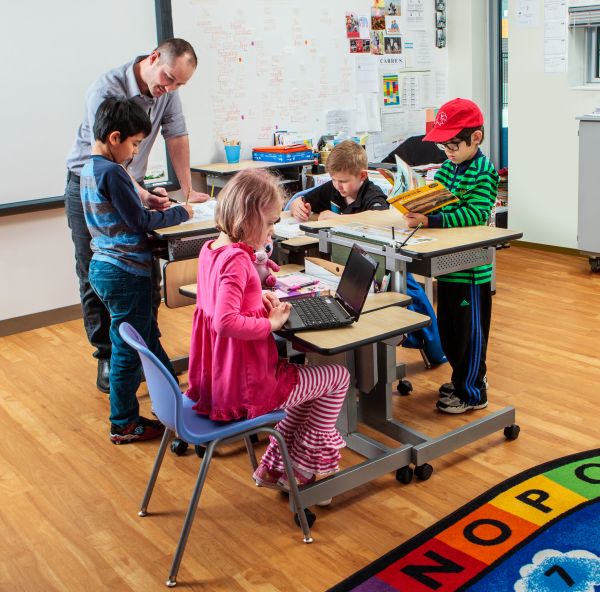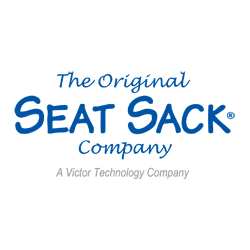In the last few years, standing desks have gone from being a novelty to a ubiquitous presence in offices worldwide. For adults, standing desks are the fastest-growing wellness benefit offered by employers. According to the Society for Human Resource Management, 44% of US employers now provide standing desks as a way to improve workers health and productivity.
This dramatic trend is also finding its way into the classroom, as researchers discover the significant benefits of encouraging children to spend more time standing and moving in school.
Children have always exhibited a primal need to move around in class, whether by fidgeting, frequent requests to use the restroom, or other disruptive behaviors. Experts believe that standing can channel that need for movement, helping children focus in class and avoiding the tendency to zone out after long periods of sitting.
“Movement-friendly desks offer great benefits for all children, especially those with learning difficulties,” says Jonathan D. Carroll, M.A., who specializes in advocacy and educational consulting for children with ADD, ADHD, and executive functioning. “Standing up helps children access working memory, improving concentration and engagement. By allowing children to self-regulate when they choose to stand, adjustable desks promote independence and responsibility.”
In addition, standing helps battle the epidemic of childhood obesity. Children in the U.S. lead increasingly sedentary lives, both in school and at home, and that inactivity has contributed to shocking rises in the number of overweight and obese kids.
Standing fights that trend in two ways: by burning more calories while in school and by breaking the cycle of continuous sitting. Kids who move in healthy ways during the school day are more likely to continue those good habits at home.
Finding the Right Fit for Every Child
While the benefits of standing apply to virtually every child, not all standing desks are created equal. The wrong desk can have unforeseen negative consequences, from poor ergonomics to classroom disruption. To create the best learning environment, next-generation classroom desks combine easy adjustability with practical features for organization, group work, and storage.
The single most important element to success is height-adjustability. Fixed-height standing desks do not take into account the wide range of sizes of children, forcing some kids to hunch over their work while others strain to reach it.
Additionally, experts acknowledge that some classroom tasks like testing and writing may be performed better when seated. High stools used with fixed-height desks provide no back support and lead to poor posture and fatigue.
According to Mary McCarthy, PT, Cert MDT, and owner of McCarthy Spine and Sport PC, “When considering a standing desk for a child, the child’s legs, torso, neck, and head must all be in line. The height of the desk should be at the level where the wrists are straight and elbows bent to 90 degrees.”
Sit/stand desks with full range of height adjustability promote the healthiest posture for every child.
It’s equally important that the adjustability of the desk not cause disruption to the class. A decade ago, the first sit/stand desks could only be adjusted by adults – a teacher or custodian would need to interrupt class and to pull out a tool kit for a student to change from sitting to standing.
Obviously, that extreme inconvenience made adjustability a moot point. Fortunately, today’s best quality sit/stand desks feature silent pneumatic lifts that children can operate themselves.
Students quickly adapt to a classroom norm where they can stand or sit as their bodies require, gaining important skills of independence and self-regulation in the process.
Practical Features that Make All the Difference
New classroom desks represent a significant investment, so it makes sense to look for features that will support all classroom functions for years to come. In considering options, keep in mind these vital design elements:
- Storage and Organization
Sit/stand desks do not have to sacrifice the storage available in traditional desks. Forward-looking manufacturers include compartments designed to hold school supplies, preferably with defined spaces for Chromebooks, notebooks, and pencils. Some inventive designs incorporate hanging folders, backpack hooks, and even pop-up study carrels, keeping kids organized and floors clutter-free.
- Mobility
Teachers love having the ability to rearrange seating easily for group projects, presentations, and other class activities. Durable, locking casters allow kids to help teachers re-set arrangements at a moment’s notice.
- Durability
Classroom furniture inevitably takes abuse, so high-quality materials and construction will make or break the success of the desks in action. Look for a sturdy steel base, durable work surface, and substantial handles for moving parts. Surfaces like high-pressure laminate offer easy clean-ups along with long life.
- Price
It’s true that good quality sit/stand desks cost more than tradition desks. However, it’s a long-term investment in a product that impacts every child every day. Protect the investment by dealing with a reputable manufacturer that stands behind its product with a strong warranty.
The classroom of the future has arrived, where non-disruptive movement is embraced as a way to enhance children’s learning and health. Schools that provide sit/stand furniture options will see positive results, as long as they make choices that support the varying needs of all children.
Nancy Dellamore is product manager for The Marvel Group’s Focus Desk product line, a series of height-adjustable desks and tables for schools and libraries, www.marvelfocusdesk.com.









